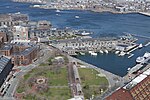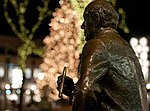Fulton-Commercial Streets District
Boston Registered Historic Place stubsHistoric districts in Suffolk County, MassachusettsHistoric districts on the National Register of Historic Places in MassachusettsNRHP infobox with nocatNational Register of Historic Places in Boston ... and 1 more
North End, Boston

The Fulton-Commercial Streets District is a historic district encompassing a commercial area of the North End of Boston, Massachusetts. It is roughly bounded on the west by Cross Street, on the east by Lewis Street, on the north by Fulton Street, and on the south by Commercial and Mercantile Streets. It was developed during the second half of the 19th century on "made land" created by filling in the area just south of the Shawmut Peninsula as part of the Quincy Market development.The district was added to the National Register of Historic Places in 1973, and expanded slightly in 2000.
Excerpt from the Wikipedia article Fulton-Commercial Streets District (License: CC BY-SA 3.0, Authors, Images).Fulton-Commercial Streets District
Fulton Street, Boston North End
Geographical coordinates (GPS) Address Nearby Places Show on map
Geographical coordinates (GPS)
| Latitude | Longitude |
|---|---|
| N 42.361944444444 ° | E -71.053333333333 ° |
Address
Fulton Street 77,79
02109 Boston, North End
Massachusetts, United States
Open on Google Maps









